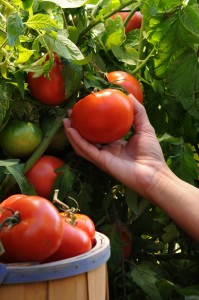Harvest Tips for Maximum Flavor
Posted in Exhibitions, The Edible Garden on August 10 2010, by Plant Talk
Written by Burpee Home Gardens Team. Burpee Home Gardens is a Supporting Sponsor of The Edible Garden.
 Harvest time is an exciting time in the garden. Those plants you have been taking care of, feeding, weeding, and watering are now returning the favor with ripe pickings for you to enjoy. Very quickly you’ll have a kitchen counter or bushel filled with red and juicy tomatoes, tasty peppers, flavorful cucumbers, and more.
Harvest time is an exciting time in the garden. Those plants you have been taking care of, feeding, weeding, and watering are now returning the favor with ripe pickings for you to enjoy. Very quickly you’ll have a kitchen counter or bushel filled with red and juicy tomatoes, tasty peppers, flavorful cucumbers, and more.
What to do with all this plenty—and when—present some of the last obstacles of the season for new vegetable gardeners. If you’re suddenly inundated with abundance, here are a few tips to remember to receive maximum flavor from your harvest:
- Tomatoes can be picked before they’re fully ripe—don’t let them over-ripen on the vine! Fruit that’s slightly green will continue to mature to red on your windowsill.
- Peppers can be harvested at any stage of growth, and some continue to ripen to red, orange, or yellow. However, their flavor doesn’t fully develop until maturity.
- Pick cucumbers when they’re small for tenderness and taste. Keep watch, though—they can grow an inch or more a day.
- Harvest often and regularly. This speeds up production of new fruit. From beans to lettuce to tomatoes and more, the more you pick, the more you’ll produce!
- For herbs like basil and cilantro, harvest before your plants start to flower for best flavor. Also, pick full stems rather than removing individual leaves. Cut just above each pair of lower leaves for bushy, compact plants.
- For the best tasting lettuce, try to harvest in the morning when the leaves are crisp, sweet, and full of moisture.
The shelf life of freshly picked vegetables is amazingly brief: Once picked, the clock starts ticking fast! Plan ahead with ready-to-go recipes or friends willing to take the excess off your hands. Our Web site offers other helpful advice for using or storing your yield.
However you choose to prepare your homegrown vegetables, remember to take the time to congratulate yourself on a job well done. Take notes on what went well in the garden, what didn’t, and what you’d like to try next. Treat this year’s harvest as a great starting point to next year’s vegetable gardening season.

